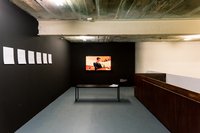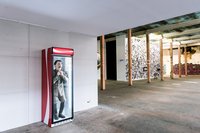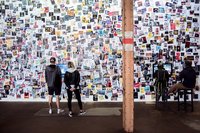THE ENDS OF FREEDOM

September 7 - December 7, 2019
Opening: Saturday, September 7, 2019, 3 pm
Gallery Tour of the SpinnereiGalleries: 7th-8th September 2019
Guided Tours: Every Saturday, 3 pm
Makoto Aida, Ines Doujak, Işıl Eğrikavuk, INDECLINE, Eugenio Merino, Csaba Nemes, Tools for Action, Wen Yau
at the end: W ... T ... F went WRRONNNNG?
It seems like not so long ago that the art world had had enough, complaining: anything goes. The avant-garde desire for freedom – to subordinate everything to the artistic gesture, to recognize no authority outside its own sphere, to more than just ignore public taste – ran its course long ago. Instead of building an alternative narrative, postmodernism refused them all: art and history had reached their final stage of maximum freedom. Spurred by digital, limitless, non-hierarchical communication, the age of democratization, liberalization and globalization had begun with no alternatives.
disRUPT_tion
This former certainty is gone today. The tectonics of social emotional structures have slipped their foundations. The present appears as a permanent state of crisis, as a reversal of all values. Even the happy few, the privileged societies of the liberalized world community, are no longer intact. They are driven by fears, especially the fear of losing their privileges. Consensus and solidarity were yesterday. Everyone for themselves! ... even at the expense of humanity. Everywhere one sees liberties threatened. Some say there are limits on speech everywhere.Others fear the restriction of guaranteed rights.
it’s TIME.. to GET {NERRRRRRRR-VOUS}?
An authoritarian backlash has hold of the democracies. Between 1994 and 2011 Italy’s media mogul Silvio Berlusconi served as prime minister four times. Vladimir Putin has been controlling Russia’s democracy since 1999. Since 2000 the FPÖ, a radical right-wing party, has been part of Austria’s government. For ten years after the electoral victory of the Danish People’s Party in 2001, the minority government in Copenhagen was only able to govern with their acquiescence. Since 2003 Recep Tayyip Erdogan is the strong man in Turkey. In 2018, he reconfigured the government into a bespoke presidential democracy. In 2010 Viktor Orbán was again selected prime minister of Hungary and has created an illiberal democracy on Putin’s model. In 2012, the culturally reactionary, economically liberal premier of Japan – Shinzo Abe – discovered social media as a means for slanderous attacks on political opponents and the media. Hong Kong’s citizens and youth have been resisting the erosion of their freedoms by the Chinese government for years. With the electoral victory of the PiS in 2015, the Polish constitution went into crisis. In the same year, multi-billionaire Donald Trump – with his contemptuous, attention-grabbing posturing – took over the Republican Party and, in 2017, the most powerful office in the world. The True Finns, the Sweden Democrats, the Danish People’s Party, the Five Star Movement in Italy and the Alternative for Germany have twisted the political discourse in Europe to the right, celebrating electoral successes and participating in government coalitions. 2019 brought Jair Bolsonaro into Brazil’s presidency with a racist, anti-woman, anti-gay election campaign.
Who...’sssss NXT? {...}
The new populism turns against actual or alleged elites and against the sometimes false consensus in political life. The mainstream parties are no longer the voice of the people. The vox populi speaks on social media. Not infrequently, it becomes antisocial and dismal: troll factories, shitstorms, hate speech, baiting, filter bubbles, social robots, voter manipulation. Ultimately, it is an antipolitics that aims at division and reinforces centrifugal social forces. Exclusionary ridicule, provocation and political incorrectness have become weapons of these movements. Reflexive outrage and admonitions about democratic and ethical standards are factored in. Ironically, freedom of religion and expression is invoked against them. »I’ve got a right to my opinion!« Culture and art have fallen into this vortex and have again become a site of dispute – the same with the cultures of remembering and forgetting.
SoliiiiidaritiiiiIIIEE_LOST?
The show introduces artists and artist groups who resist authoritarian powers in their countries, who take to the streets, who participate in the social negotiation process and who call attention to threats and in turn provoke them. What political and artistic restrictions do they face? Where have there been cases of exertion of political influence and censorship? Where have artists endangered themselves? How and with whom do the artists feel solidarity? Who is in solidarity with them? Which prescriptions can art offer for regaining one’s own agency? Is it time for art to be ... to again be ... to become political? Or is it just too late? Is escape an alternative? Escape to where or into what? Ultimately, this project wants to animate people to recognize their own agency, to speak instead of remaining silent and to seek dialogue instead of confrontation.

Makoto Aida
In the summer 2015 there was a dispute over a summer exhibition for children at the Museum of Contemporary Art Tokyo. The curators wanted to make it more sophisticated than the usual children’s exhibitions. They invited, among others, MAKOTO AIDA, one of the best known but also most controversial contemporary Japanese artists. »The curator asked me to create something more challenging, so I think I’ve answered to that,« says Aida . But after the opening of the exhibition »An Art Exhibition for Children – Whose Place Is This?« a complaint came from a visitor, whereupon the city government, which operates the museum, intervened. Aida claims that he was asked by the curators to remove two of his works from the exhibition. A spokeswoman for the museum denies this. They simply asked for a change in the work: »We asked him if he could make it more accessible to children.«
The dispute revolved around a large banner with the title »Manifesto« and a video work. The six-meter-long banner was inscribed with complaints from Aida and his family to the Ministry of Education. »Most families talk at home about education. My wife and son have complained to his school, so the work is a kind of example of my family’s complaint,« explains Aida. »It’s not a radical thing … I am not anti-government.« In the video, Aida pretends to speak as the Japanese Prime Minister before an international gathering. Although no reference is made to Shinzo Abe, it is clear that he is meant when Aida , in broken English, vilifies »globalization« and declares the absolute isolation of Japan.
»In Japan’s present climate of historical revisionism and censorship, Aida is the nail that sticks up,« journalist Lucy Birmingham comments. »As such, he certainly gets people thinking. For children, this is supposed to be a good thing.« »Self-censorship is a big issue in Japan, more problematic than censorship imposed from outside.« says curator Natsumi Araki. She works for the privately operated and financed Mori Art Museum, which therefore can act more freely than public institutions.

Ines Doujak
A rundown sailboat lies off the coast of Chile. Captain Delano would like to help the strangers, but he finds it difficult to interpret the conditions on board. Delano does not yet know that the slaves on board have taken power and only pretend that the Spaniards are still in command. Because Delano cannot see the skeleton of the slave merchant—which the rebels have nailed to the prow where the figure of Christopher Columbus used to be—the true meaning of the inscription »Seguid a vuestro jefe« (»follow your leader« remains hidden from him. Each morning, the surviving crew members have to make their way to the bow, where they hear the following warning: »Keep faith with the blacks from here to Senegal, or you shall in spirit, as now in body, follow your leader.« The slaves want to force the crew to return them to their homeland. The bizarre scene that Herman Melville imagines in his story »Benito Cereno« from 1855 is a reversal of the relationship between master and servant.
Melville’s story is the starting point for INES DOUJAK’S multi-layered installation, which poses questions about the historical entanglement of power, violence and revolt, and racism and sexism. »At the same time it explores the poetic and imaginary resources of revolutionary resistance, of resistance at all.« (Roger M. Buergel) Viewers are greeted by a Plexiglas armada of ten American, European, Soviet and Japanese cruisers and destroyers. On the starboard it is covered with brown fur and on the port with photographs. Doujak discovered that skinheads reference a letter from Carl Schmitt, a legal theorist with Nazi ties, that he signed with the name of the Spanish captain, Benito Cereno. In a bizarre twist, Schmitt claimed that he and other members of the intelligentsia were intellectual hostages under Hitler. Together with Viennese hooligans, Doujak reconstructed episodes from Melville’s short story for the photos.
On each warship hang five painted ostrich eggs. These exotic souvenirs were often exhibited in European cabinets of curiosities during colonial times. On the eggs are scenes and details of social unrest and revolts in which women play a central role: Chechen suicide bombers, Kurdish militants, organizations opposing trafficking in women, the feminist anarchists of the Spanish Civil War and many more. Against the tendency to simplify the contradictions of history in historical narratives, Doujak’s strategy is to overload symbols with meanings. In this overload, the seemingly irrefutable past becomes fluid again and raises questions such as: Why actually are things as they are? …and do they have to be that way?

Işıl Eğrikavuk
For many years, YAMA was Istanbul’s most visible art project in public space. Videos by famous artists were shown at night from the roof of the Mamara Pera Hotel. The video »Time to Sing a New Song« by IŞıL EĞRIKAVUK was supposed to have run there for ten weeks in the spring of 2016, but after just three days, the nine by six meter screen went dark.
When YAMA curator Övül Ö. Durmus¸oglu inquired at the hotel what had happened, she learned that after anonymous complaints, the police ordered the monitor turned off. It was said that this new work violated religious feelings. In the short animation, a female emoji face turns into an apple and proclaims »Finish up your apple, Eve!« instead of passing it on to Adam. »This slogan says >no< to religious mythical stories that are created by a dominant male language, but also to the current situation in Turkey where hundreds of women are killed by male violence every year,« says Eğrikavuk, describing her motivation for this work. Despite protest from YAMA and the artist, the video remained shut down.
»Censorship in the arts, in academies, in journalism and in every form of speech is getting wider and more internalized. On the other hand, I am really interested in how, as artists we can deal with this situation. For the past three years there is definitely a shift to act collectively,« stated the artist at the time, who also works as a journalist, »but in general, we are going through some really dark times.« Together with her students, Eğrikavuk responded to the ban in the form of the performance »A Fairytale on Benefits of An Apple«.
As part of this ban it became known that the hotel was asked once before by the police to turn off a video, at the beginning 2016. Now, due to »visual pollution«, the continuation of the entire YAMA program has been prohibited. For experts, this case is typical of censorship in Turkey, which avoids direct bans and likes to use other rules to stop critical art. There are numerous other cases of interference by the authorities, cancellations of exhibitions and arrests of representatives of the cultural scene.

Eugenio Merino
Even 40 Years after the death of Francisco Franco in 1975 and Spain’s transition from dictatorship to democracy, the painful past is still present and the historical processing has barely begun. In 2007 Prime Minister Zapatero, whose grandfather was killed by Franco’s forces, ordered the removal of public symbols honoring Franco, such as street signs and statues. But even today there are many streets in Spain dedicated to the dictator and his generals. Numerous mass graves have not yet been opened, and the victims never properly buried. In 2010 a well-known judge began to investigate the crimes of the Franco era, but he was suspended.
The first time EUGENIO MERINO showed his sculpture »Always Franco« at the Madrid art fair ARCO in 2012, it angered supporters of the dictator. »I put him inside a fridge because I thought he was still fresh, he‘s still present in our society,« the artist says of his work. The Francisco Franco Foundation sued the artist, so that he had to appear twice before the court. »These people on the left that call themselves artists or writers have a very serious problem,« said the foundation’s vice president. »They want us to believe that history was different than how it really was. They feel the need to claim that the nearly 40 years of the Francisco Franco regime were black years, of ostracism and persecution.« But the courts ruled that Merino’s artistic expression was legitimate.
Merino has placed many more dictators in coolers. In the exhibition here, 30 years after the end of socialism, Stalin is in the fridge. Maybe there is also still something fresh here? That dictatorships are not a thing of the past is also demonstrated by Merino’s sculptures of authoritarian rulers from present times. In »Punching Putin« the head of the »steered« democracy of Russia becomes a standing punching bag. Does someone want to take a swing? The »Toxic Trump« package features a highly poisonous shipment: the head of Donald Trump.
With a group of other people, Merino also publishes the non-profit-oriented art magazine »Sublime«. A few years ago, they decided that they had to engage more with the politically important issues of the time—against neoliberalism and fascism. Trump is featured on the cover of the first issue in 2018. His baseball cap reads: Make Political Art Great Again!

Csaba Nemes
HUNGARY’S PRIME MINISTER Viktor Orbán had actually announced his intention to talk with critics of his plans for a memorial to the victims of German occupation during World War II. But on April 8, 2014 — two days after his party’s successful parliamentary election — work began in a covert action on Freedom Square in Budapest.
In the center of an ensemble reminiscent of a Greek temple, the Archangel Gabriel is attacked by an eagle. The protesters see in this work a falsification of history, because Hungary was not so innocent at the time as this allegory pretends. Even before the occupation, Hungary was an ally of Germany in World War II and had introduced many laws discriminating against Jews. 600,000 Hungarian Jews were deported to German concentration camps and murdered. »Hundreds of thousands of Hungarians volunteered to participate in the crimes because they supported Germany’s plans,« says Maria M. Kovács. Together with like-minded people from the arts and sciences, she founded the group Eleven Emlékmű (Living Memorial), which participated in the protests against this monument. They created a countermonument of personal belongings and photos to remind of the family losses during the German occupation. Here many more shades of historical gray were visible than in the simple metaphor of the attacked angel. White chairs became the symbol of the initiative, which organized open discussions on Freedom Square: sit down to share and to listen. »With its resilience, Living Memorial has been a great example of building communities with the goal of creating a responsible civil society that is capable of discussing difficult issues and standing up when human rights are threatened,« writes Budapest art critic Vanda Saraí.
The artist CSABA NEMES was part of this group and memorializes the actions in his print series »Testimony of Democracy«. In his painting series »Occupy Monument« he imagines the controversial monument already forgotten and overgrown by plants. In fact, the monument has still not been officially inaugurated. Nemes says, »For years, I’ve invested a lot of energy in this protest, but I do not think activism in illiberal democracy works very well. I’ve turned more to the institutional setting to express my thoughts.« Nemes’ series of photo paintings »Redirect« deals with the history of the appearance, disappearance and reappearance of monuments on Budapest’s central squares in the past 100 years.
Also the video »Let’s!«, staged in the Hungarian National Museum with references to Jean-Luc Godard’s »Bande à part« (1964) and »The Confrontation« (1969) by Miklós Jancsó, is an invitation, actively questioning the current form of national art historiography.

Tools for Action
The highest party leader has come to appraise the success of orange cultivation in Hungary. The communist state wants to become more independent of world trade, but the subtropical fruits do poorly. Instead of an orange, the esteemed guest will be presented with a lemon. The head of the experiment explains: »It’s the new Hungarian orange! A bit more yellow, a bit more sour, but it’s ours!« This scene comes from the satirical film »The Witness« (Péter Bacsó, 1969), which was long banned in Hungary. It aptly caricatured the gap between communist propaganda and reality and entered the cultural consciousness of Hungary. A Budapest satirical magazine bears the name »Hungarian Orange« and the Fidesz party logo is also directly related to this fruit.
The beginning of the uprising against the communist dictatorship on October 23, 1956 is commemorated each year in Hungary with demonstrations. In 2012 there was a public rivalry: who can mobilize most people—the supporters of Orbán or the freedom of the press supporting opposition? With other colleagues, Artúr van Balen decided to revive the »Hungarian Orange« for the occasion. They made a giant inflatable lemon, with which they first went to the meeting of Fidesz. The mostly older demonstrators responded more aggressively than expected, swearing at the group around van Balen and destroying the inflatable sculpture. After their retreat, the activists made makeshift repairs to the lemon in a side street and went on to the opposition demo, where they were received joyfully and playfully. »Experiencing the 23rd of October in Budapest showed me how emotionally polarized and divided Hungary is at the moment,« said van Balen, summing up his memory.
Since then, the artist uses the playful and delightful art of inflatable objects as a means of intervention with his platform TOOLS FOR ACTION Foundation*, established in 2012. It experiments with new forms of assembly and explores the political significance of commemoration. In the long-prepared, large-scale action »The Mirror Barricade«, people from Dortmund built 110 large cubes of reflective film to creatively protest with dance against a 2016 National Socialist mass demo. On the occasion of the 100th anniversary of the 1918 November Revolution, Artúr van Balen and Tomás Espinosa in collaboration with Kulturprojekte Berlin carried out the action »Signals, Resonating Revolutions« with luminous objects. A year later, on November 9th they will perform a sequel in Dresden (»Signals 3.0«). The focus this time is on the current upheavals 30 years after the fall of the Berlin Wall and the contradictory nature of this German day of remembrance, which is also the anniversary of the anti-Semitic pogroms of 1938. The signal lamps shown here will be used in Dresden. Visitors are invited to come participate in the action. Can we initiate a new form of commemoration in relationship to the 9th of November?

Wen Yau
The people of Hong Kong have been protesting with great perseverance all summer in 2019 against the proposed law that would for the first time allow extradition to China. Head of government Carrie Lam shows herself to equally unrelenting: only after countless mass protests, blockades and much violence did she announce the repeal of the law. Hong Kong author Evan Fowler describes her style of politics thusly: »Rather than seeking to heal divisions through empathy, sensitivity and understanding, her administration sought unity by doing all it could to suppress all but the official narrative. It is a style of governing and understanding of authority that is distinctly more authoritarian, more Chinese Communist Party than Hong Kong, (…).«
Hong Kong’s youth have already been protesting since 2011, most notably in 2014. Inspired by the worldwide Occupy Movement, the battle for Civic Square was sparked. Once created for public assembly, the park was then sealed off by authorities. A decentralized movement developed from the occupation, whose global trademark became the umbrella. Like many other artists, WEN YAU has been involved in the protests since that time. It started with a parodic intervention with Clara Cheung. With posters like »I’m against Occupy Central because they do not pay me«, they tried to confuse and provoke counterdemonstrators. With like-minded people they collected umbrellas and invited passers-by to express their feelings about the protest movement with the umbrellas. Since these actions, Wen Yau has been closely associated with the movement, writing a book on performance art and activism in Hong Kong. Even now she again participates in the protests. The installation shown here gathers current posters, flyers and videos that she has collected from artists friends and other protestors.
The result is a »Lennon Wall« as currently exist in many places in Hong Kong. The name refers to John Lennon’s sung prompt »Imagine« and serves to exchange wishes, dreams and messages among the protesters. It is a picture of the resilient and versatile spirit of resistance. »It touches me a lot that the voices from Hong Kong are heard loudly in Leipzig,« says the artist, who in the work’s title—»Wir sind das Volk!« (We are the people)—also makes reference to local democratic movements. On November 7, 2019 Wen Yau will come to Leipzig to report on the protest in Hong Kong through a performance.
Funded by






